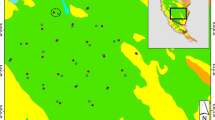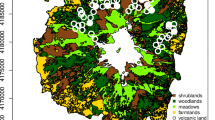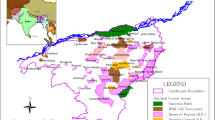Abstract
The use of camera traps is prevalent in the ecological study of giant pandas (Ailuropoda melanoleuca). The reliability of camera-trap surveying results greatly depends on sampling designs that significantly influence the detection probability of the target species. Few studies have tested the efficacy of sampling designs on camera-trap surveys for monitoring giant pandas in a heterogeneous landscape. In this study, we conducted camera trapping of giant pandas based on two different sampling schemes in Changqing National Nature Reserve of China, and evaluated their outcomes based on three aspects: occupancy analysis, photographic rate, and activity pattern. The results demonstrated that both climate heterogeneity and distance to the nearest road had a strong positive influence on site occupancy, and slope and forest cover had a significant negative impact on site occupancy. Significant differences in the direction or magnitude of variables’ influences indicated that there were apparently spatial-temporal dynamics of giant panda distribution between two sampling schemes. The low detection probabilities indicated that both sampling schemes were not robust to accurately monitor giant pandas in the whole study area. We recommended that more suitable sampling designs with local covariates be developed for camera-trap surveys monitoring giant pandas to account for temporal variability and small-scale variation in heterogeneous landscapes.





Similar content being viewed by others
References
Alexander JS, Gopalaswamy AM, Shi K, Hughes J, Riordan P (2016) Patterns of snow leopard site use in an increasingly human-dominated landscape. PLoS One 11:e0155309. https://doi.org/10.1371/journal.pone.0155309
Bai W, Huang Q, Zhang J, Stabach J, Huang J, Yang H, Songer M, Connor T, Liu J, Zhou S, Zhang H, Zhou C, Hull V (2020) Microhabitat selection by giant pandas. Biol Conserv 247:108615. https://doi.org/10.1016/j.biocon.2020.108615
Beaudrot L, Ahumada J, O’Brien TG, Jansen PA (2019) Detecting tropical wildlife declines through camera-trap monitoring: an evaluation of the tropical ecology assessment and monitoring protocol. Oryx 53:126–129. https://doi.org/10.1017/S0030605318000546
Brassine E, Parker D (2015) Trapping elusive cats: using intensive camera trapping to estimate the density of a rare African felid. PLoS One 10:e0142508. https://doi.org/10.1371/journal.pone.0142508
Burnham KP, Anderson DR (2002) Model selection and multimodel inference: a practical information-theoretic approach, 2nd edn. Springer-Verlag, New York
Burton AC, Neilson E, Moreira D, Ladle A, Steenweg R, Fisher JT, Bayne E, Boutin S (2015) Review: wildlife camera trapping: a review and recommendations for linking surveys to ecological processes. J Appl Ecol 52:675–685. https://doi.org/10.1111/1365-2664.12432
Fan J, Li J, Quan Z, Wu X, Hu L, Yang Q (2011) Impact of road construction on giant panda’s habitat and its carrying capacity in Qinling Mountains. Acta Ecol Sin 31:145–149. https://doi.org/10.1016/j.chnaes.2011.03.003
Feng T-T, van Manen FT, Zhao N-X, Li M, Wei FW (2009) Habitat assessment for giant pandas in the Qinling Mountain region of China. J Wildl Manage 73:852–858. https://doi.org/10.2193/2008-186
Gu W, Swihart RK (2004) Absent or undetected? Effects of non-detection of species occurrence on wildlife-habitat models. Biol Conserv 116:195–203. https://doi.org/10.1016/S0006-3207(03)00190-3
Hijmans RJ, Cameron SE, Parra JL, Jones PG, Jarvis A (2005) Very high resolution interpolated climate surfaces for global land areas. Int J Climatol 25:1965–1978. https://doi.org/10.1002/joc.1276
Hines JE (2006) Presence - software to estimate patch occupancy and related parameters. USGS-PWRC. http://www.mbr-pwrc.usgs.gov/software/presence.html. Accessed 14 Oct 2019
Hull V, Roloff G, Zhang J, Liu W, Zhou S, Huang J, Xu W, Ouyang Z, Zhang H, Liu J (2014) A synthesis of giant panda habitat selection. Ursus 25:148–162. https://doi.org/10.2192/URSUS-D-13-00011.1
Hull V, Zhang J, Huang J, Zhou S, Viña A, Shortridge A, Li R, Liu D, Xu W, Ouyang Z, Zhang H, Liu J (2016) Habitat use and selection by giant pandas. PLoS One 11:e0162266. https://doi.org/10.1371/journal.pone.0162266
Kang D, Li J (2019) Giant panda protection: challenges and hopes. Environ Sci Pollut Res Int 26:18001–18002. https://doi.org/10.1007/s11356-019-05404-7
Karanth KU, Gopalaswamy AM, Kumar NS, Vaidyanathan S, Nichols JD, MacKenzie DI (2011) Monitoring carnivore populations at the landscape scale: occupancy modelling of tigers from sign surveys. J Appl Ecol 48:1048–1056. https://doi.org/10.1111/j.1365-2664.2011.02002.x
Kays R, Arbogast BS, Baker-Whatton M, Beirne C, Boone HM, Bowler M, Burneo SF, Cove MV, Ding P, Espinosa S, Gonçalves ALS, Hansen CP, Jansen PA, Kolowski JM, Knowles TW, Lima MGM, Millspaugh J, McShea WJ, Pacifici K et al (2020) An empirical evaluation of camera trap study design: how many, how long and when? Methods Ecol Evol 11:700–713. https://doi.org/10.1111/2041-210x.13370
Li S, Mcshea WJ, Wang D et al (2010) The use of infrared-triggered cameras for surveying phasianids in Sichuan Province, China. Ibis 152:299–309. https://doi.org/10.1111/j.1474-919X.2009.00989.x
Li S, McShea WJ, Wang D et al (2012) A direct comparison of camera-trapping and sign transects for monitoring wildlife in the Wanglang National Nature Reserve, China. Wildl Soc Bull 36:538–545. https://doi.org/10.1002/wsb.161
Li S, Wang D, Xiao Z et al (2014)Camera-trapping in wildlife research and conservation in China: review and outlook. Biodivers Sci 22:685–695 (in Chinese). https://doi.org/10.3724/SP.J.1003.2014.14203
Liu X, Toxopeus AG, Skidmore AK et al (2005) Giant panda habitat selection in Foping Nature Reserve, China. J Wildl Manage 69:1623–1632. https://doi.org/10.2193/0022-541x(2005)69[1623:gphsif]2.0.co;2
Long RA, MacKay P, Zielinski WJ, Ray JC (2008) Noninvasive survey methods for carnivores. Island Press, Washington
Long RA, Donovan TM, MacKay P, Zielinski WJ, Buzas JS (2011) Predicting carnivore occurrence with noninvasive surveys and occupancy modeling. Landsc Ecol 26:327–340. https://doi.org/10.1007/s10980-010-9547-1
Lu X, Jiang Z, Tang J et al (2005)Auto-trigger camera traps for studying giant panda and its sympatric wildlife species. Acta Zool Sin 51:495–500 (in Chinese). https://doi.org/10.3969/j.issn.1674-5507.2005.03.016
Lucherini M, Reppucci JI, Walker RS, Villalba ML, Wurstten A, Gallardo G, Iriarte A, Villalobos R, Perovic P (2009) Activity pattern segregation of carnivores in the high Andes. J Mammal 90:1404–1409. https://doi.org/10.1644/09-mamm-a-002r.1
MacKenzie DI, Bailey LL (2004) Assessing the fit of site-occupancy models. J Agric Biol Environ Stat 9:300–318. https://doi.org/10.1198/108571104X3361
MacKenzie DI, Royle JA (2005) Designing occupancy studies: general advice and allocating survey effort. J Appl Ecol 42:1105–1114. https://doi.org/10.1111/j.1365-2664.2005.01098.x
MacKenzie DI, Nichols JD, Lachman GB et al (2002) Estimating site occupancy rates when detection probabilities are less than one. Ecology 83:2248–2255. https://doi.org/10.1890/0012-9658(2002)083[2248:ESORWD]2.0.CO;2
MacKenzie DI, Nichols JD, Royle JA et al (2018a) Design of single-season occupancy studies. In: MacKenzie DI, Nichols JD, Royle JA et al (eds) Occupancy estimation and modeling, 2nd edn. Academic Press, Boston, pp 439–476
MacKenzie DI, Nichols JD, Royle JA et al (2018b) Fundamental principles of statistical inference. In: MacKenzie DI, Nichols JD, Royle JA et al (eds) Occupancy estimation and modeling, 2nd edn. Academic Press, Boston, pp 71–111
Pan W, Lyu Z, Zhu X et al (2001a) The migration and activities of giant pandas. In: Shang H, Li B (eds) The last chance to survive. Peking University Press, Beijing, pp 118–156 (in Chinese)
Pan W, Lyu Z, Zhu X et al (2001b) The home range of giant pandas. In: Shang H, Li B (eds) The last chance to survive. Peking University Press, Beijing, pp 73–116 (in Chinese)
Pei K (1998) An evaluation of using auto-trigger cameras to record activity patterns of wild animals. Taiwan J For Sci 13:317–324 (in Chinese)
Rovero F, Zimmermann F, Berzi D, Meek P (2013) “Which camera trap type and how many do I need?” a review of camera features and study designs for a range of wildlife research applications. Hystrix, Ital J Mammal 24:148–156. https://doi.org/10.4404/hystrix-24.2-8789
Shannon G, Lewis JS, Gerber BD (2014) Recommended survey designs for occupancy modelling using motion-activated cameras: insights from empirical wildlife data. PeerJ 2:e532. https://doi.org/10.7717/PEERJ.532
Silveira LF, de Beisiegel BM, Curcio FF et al (2010) Para que servem os inventários de fauna? Estud Avançados 24:173–207. https://doi.org/10.1590/S0103-40142010000100015
Srbek-Araujo AC, Chiarello A (2013) Influence of camera-trap sampling design on mammal species capture rates and community structures in southeastern Brazil. Biota Neotrop 13:51–62. https://doi.org/10.1590/S1676-06032013000200005
Swaisgood RR, Wei F, Wildt DE, Kouba AJ, Zhang Z (2010) Giant panda conservation science: how far we have come. Biol Lett 6:143–145. https://doi.org/10.1098/rsbl.2009.0786
Tachikawa T, Kaku M, Iwasaki A, et al (2011) Aster global digital elevation model version 2 - summary of validation results
Theuerkauf J, Jȩdrzejewski W, Schmidt K et al (2003) Daily patterns and duration of wolf Activity in the Białowieza Forest, Poland. J Mammal 84:243–253. https://doi.org/10.1644/1545-1542(2003)084<0243:Dpadow>2.0.Co;2
Wang F, McShea W, Wang D et al (2014) Evaluating landscape options for corridor restoration between giant panda reserves. PLoS One 9:e105086. https://doi.org/10.1371/journal.pone.0105086
Wang F, McShea WJ, Wang D, Li S (2015) Shared resources between giant panda and sympatric wild and domestic mammals. Biol Conserv 186:319–325. https://doi.org/10.1016/j.biocon.2015.03.032
Wei F, Zhang Z, Hu J (2011) Research advances and perspectives on the ecology of wild giant pandas. Acta Theriol Sin 31:412–421 (in Chinese)
Wei W, Swaisgood RR, Dai Q, Yang Z, Yuan S, Owen MA, Pilfold NW, Yang X, Gu X, Zhou H, Han H, Zhang J, Hong M, Zhang Z (2018) Giant panda distributional and habitat-use shifts in a changing landscape. Conserv Lett 11:e12575. https://doi.org/10.1111/conl.12575
Ye X, Yu X, Wang T (2020) Investigating spatial non-stationary environmental effects on the distribution of giant pandas in the Qinling Mountains, China. Glob Ecol Conserv 21:e00894. https://doi.org/10.1016/j.gecco.2019.e00894
Zhang J, Li Y, Li R (2015) Application of infrared camera technology in studies of mammal activity patterns. Sichuan J Zool 34:671–676 (in Chinese). https://doi.org/10.11984/j.issn.1000-7083.20150172
Zhang Y, Mathewson PD, Zhang Q, Porter WP, Ran J (2018) An ecophysiological perspective on likely giant panda habitat responses to climate change. Glob Chang Biol 24:1804–1816. https://doi.org/10.1111/gcb.14022
Zhou L, Zhang X, Jiu Q, Meng X (2017) The pandas of Qinling-the 4th survey report on giant pandas in Shaanxi Province. Shaanxi Science & Technology Press, Xi’an (in Chinese)
Acknowledgements
We thank the Administration of Shaanxi Changqing National Nature Reserve for assistance with fieldwork. We also thank the editor and anonymous reviewers who provided constructive comments on the early version of the manuscript.
Availability of data and materials
The datasets used and/or analyzed during the current study are available from the corresponding author on reasonable request.
Funding
This work was supported by the National Natural Science Foundation of China (31672310), the National Key Research and Development Program of China (2016YFC0503200), and Shaanxi Provincial Key Research and Development Program (2020ZDLSF06-01).
Author information
Authors and Affiliations
Contributions
Conceptualization, Z.C. and X.Y.; methodology, Z.C.; software, Z.C., W.Z., and Y.Z.; formal analysis, Z.C., W.Z., and Y.Z.; investigation, N.Z. and G.S.; original draft preparation, Z.C.; review and editing, X.Y. and X.Y.; project administration, X.Y.; and funding acquisition, X.Y. and X.Y.
Corresponding author
Ethics declarations
Ethics approval and consent to participate
Not applicable.
Consent for publication
Not applicable.
Competing interests
The authors declare no competing interests.
Additional information
Responsible Editor: Philippe Garrigues
Publisher’s note
Springer Nature remains neutral with regard to jurisdictional claims in published maps and institutional affiliations.
Rights and permissions
About this article
Cite this article
Cui, Z., Zhao, W., Zhang, Y. et al. Testing the efficacy of camera-trap sampling designs for monitoring giant pandas in a heterogeneous landscape. Environ Sci Pollut Res 29, 14098–14110 (2022). https://doi.org/10.1007/s11356-021-16765-3
Received:
Accepted:
Published:
Issue Date:
DOI: https://doi.org/10.1007/s11356-021-16765-3




